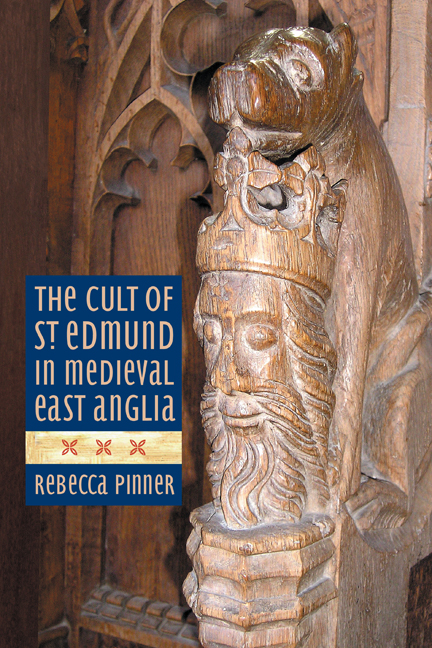Book contents
- Frontmatter
- Contents
- List of Illustrations
- Acknowledgements
- Abbreviations
- Introduction
- Part I Texts and Contexts: the Legend of St Edmund
- Part II Relics, Shrines and Pilgrimage: Encountering St Edmund at Bury
- Part III Beyond Bury: Dissemination and Appropriation
- Conclusion: ‘Martir, Mayde and Kynge’, and More
- Appendix 1 Synoptic Account of the Legend of St Edmund
- Appendix 2 Chronology of Significant Events and Texts Associated with the Cult of St Edmund
- Bibliography
- Index
Appendix 2 - Chronology of Significant Events and Texts Associated with the Cult of St Edmund
Published online by Cambridge University Press: 21 May 2021
- Frontmatter
- Contents
- List of Illustrations
- Acknowledgements
- Abbreviations
- Introduction
- Part I Texts and Contexts: the Legend of St Edmund
- Part II Relics, Shrines and Pilgrimage: Encountering St Edmund at Bury
- Part III Beyond Bury: Dissemination and Appropriation
- Conclusion: ‘Martir, Mayde and Kynge’, and More
- Appendix 1 Synoptic Account of the Legend of St Edmund
- Appendix 2 Chronology of Significant Events and Texts Associated with the Cult of St Edmund
- Bibliography
- Index
Summary
c. 840? Edmund born ‘of Old Saxon stock’
c. 855? Edmund crowned King of East Anglia at Bures (Suffolk)
865 The Great Heathen army invades. Edmund barters horses with the Vikings and they march north to Yorkshire
869 The Vikings return to East Anglia. Edmund is captured and killed
878 Alfred defeats the Vikings at the Battle of Ethandun
c.890 The first account of Edmund's death recorded in the Anglo-Saxon Chronicle (Parker manuscript)
893 Asser includes Edmund's death in his Vita Ælfredi Regis Angul Saxonum
c.895–910 St Edmund memorial coinage issued
c.905? Edmund's remains translated to Beodricesworth (later Bury) from their original burial place at ‘Sutton’
945 King Edmund grants the secular community control over the banleuca
c.985–7 Abbo of Fleury, Passio Sancti Edmundi
1010 A Danish army under the leadership of Thurkill the Tall lands at Ipswich. Egelwyn travels with Edmund's relics to London
1013 Edmund's relics returned to Bury St Edmunds
1013 King Sweyn Forkbeard claims control of England. King Æthelred ‘the unready’ flees England
1014 King Sweyn dies suddenly, allegedly speared by St Edmund
1020 King Cnut replaces the community of secular clerics with Benedictine monks
1021 King Cnut grants the abbey a charter of privileges
1032 Rebuilt or extended abbey church consecrated by Archbishop Æthelnoth
1043 King Edward the Confessor visits Bury and grants the abbey jurisdiction over the eight and a half hundreds of West Suffolk
1044–65 Abbot Leofstan inspects Edmund's remains and finds them intact and uncorrupted
Mid. 11th C Earliest known version of Abbo's Passio preserved in Lambeth Palace Library, London, MS 361
c.1150–56 Geoffrey of Wells, De Infantia Sancti Edmundi
1153 Abbey estates pillaged by Eustace, son of King Stephen, when the abbey refused his demands for money
1065–97/98 Baldwin abbot of Bury St Edmunds
1066 The Norman Conquest of England
1070–84 Herfast bishop of East Anglia
c.1070–81 Ongoing dispute between the abbey at Bury and the episcopate concerning the location of the episcopal see
1071 Abbot Baldwin travels to Rome, via Lucca, to secure the privilege of exemption from Pope Alexander I
1081 King William I forced to intervene and settle the dispute
1095 St Edmund's relics translated into the new abbey church
Late 11th C Archdeacon Herman, De Miraculis Sancti Edmundi
- Type
- Chapter
- Information
- The Cult of St Edmund in Medieval East Anglia , pp. 248 - 250Publisher: Boydell & BrewerPrint publication year: 2015



